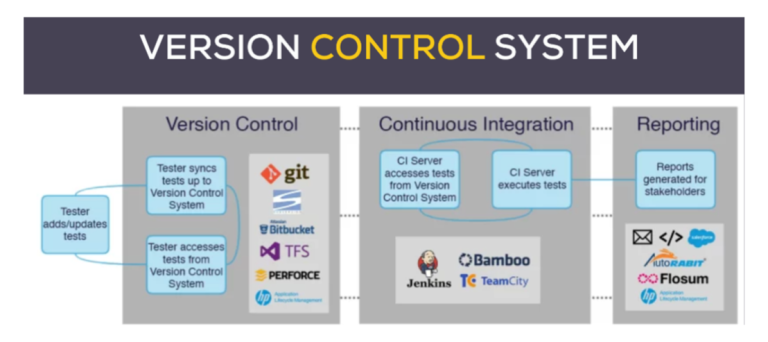Version Control: A DevOps Secret Weapon in Salesforce
Just imagine you’ve invested weeks of hard work into your team’s upcoming Salesforce app. Just when you’re about to cross the finish line, a colleague unknowingly jumps into a sandbox org to make some changes. Little did they know, their actions would obliterate all the progress you’d painstakingly made. Days, perhaps even weeks of work – gone in an instant. But what if there was a secret weapon that could have saved the day? It’s called Version Control, and in this exciting journey, we’re about to unravel its magic.
What Exactly is Version Control?
In the realm of software development, version control is the guardian angel of your code, ensuring it never loses its way. Think of it as an eternal memory for your software, where accidental deletions and irreversible overwrites are but distant nightmares. Version control is your trusty companion on the coding adventure, a silent protector of progress.
So, What's a VCS Anyway?
A VCS, or Version Control System, is the digital detective that reveals who made a change and precisely when they did it. No more tangled email threads, scribbled notes, or relying on someone’s memory. With a VCS, everything is meticulously organized, and every version of the program is securely stored, saving you from the heartache of erasing weeks of hard work.
While there are numerous version control systems out there, one shines particularly bright: a Git-based system. It’s safe to say that 87.2% of developers would agree—Git is the undisputed champion of version control.
Version Control and Salesforce DevOps

Now, you might be wondering, “What’s in it for Salesforce developers and admins?” Well, Salesforce DevOps teams are the ideal candidates for embracing modern version control. Salesforce org can be intricate, which is all the more reason to implement a well-structured version control system. It’s your ticket to cracking the code your teams are tirelessly working on.
Blue Canvas: Your Version Control Ally
Blue Canvas, is the git-based superhero that effortlessly manages versioning, backups, and continuous integration for DevOps teams. Now imagine, all your team’s changes are automatically synchronized to a git repository. It’s your safeguard, keeping a watchful eye on all your Salesforce metadata sandbox updates.
Here’s a sneak peek from bluecanvas.io of Salesforce DevOps paired with a VCS in action.
Benefits of Version Control in Salesforce DevOps
Certainly, let’s dive into the compelling world of the benefits that version control unfurls within the vibrant realm of Salesforce DevOps.
Version control is your secret sauce in the recipe for successful Salesforce DevOps. It weaves a web of collaboration, provides a trail of change breadcrumbs, and strengthens the fortress of your development environment. It’s your passport to a world of organized, efficient, and agile Salesforce development.
Challenges for Salesforce DevOps Without Version Control
The absence of version control in Salesforce DevOps is akin to wandering blindfolded through a minefield, with your clients, reputation, and sanity hanging in the balance. As the world of technology evolves at breakneck speed, DevOps teams must navigate the tumultuous seas of change. The only safe passage is through the use of effective version control.
Here are some real-life examples of what can go wrong when there’s no version control:
1. Lost Code
Think of it like writing an essay on your computer but not saving it. Without version control, the changes to the Salesforce software can disappear, and you won’t know who did what. It’s like a mystery that’s hard to solve.
2. Data Confusion
Imagine if someone changed important data, like contact information, but nobody remembers who did it or why. It can be a big mess trying to fix the data back to the way it should be.
3. Mixing Up Changes
When many people are working on the same software, their changes can collide and cause errors. Fixing these errors can be very confusing and take a lot of time.
4. Going Back in Time
Sometimes, things go wrong, and you need to go back to an older, working version of the software. Without version control, it’s like trying to find a needle in a haystack to figure out what worked before.
5. Security Troubles
Keeping software safe from hackers is essential. Without version control, it can be hard to prove that your software is secure. It’s like trying to convince a detective that you didn’t do something wrong without any evidence.
6. Teamwork Trouble
When everyone on the team doesn’t use the same system to work together, communication gets messy. It’s like trying to have a conversation when everyone is speaking different languages.
In this world full of hidden dangers, version control is your superhero cape, helping you keep things in order and protecting you from chaos. So, use version control to make sure your team is the hero that defeats the challenges of Salesforce DevOps.
Wrapping Up!
So, there you have it – you’ve unlocked the mysteries of version control, delved into the inner workings of version control systems, and witnessed its transformative impact on Salesforce DevOps. The good thing is, that you’re no longer a newbie to the DevOps world; you’re now armed with the secret weapon of version control.





I enjoyed it just as much as you will be able to accomplish here. You should be apprehensive about providing the following, but the sketch is lovely and the writing is stylish; yet, you should definitely return back as you will be doing this walk so frequently.